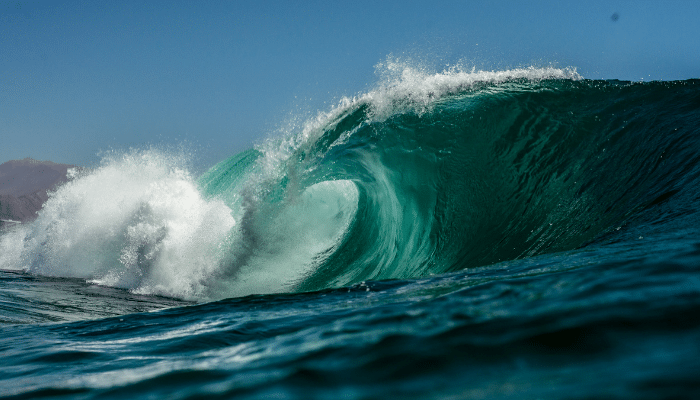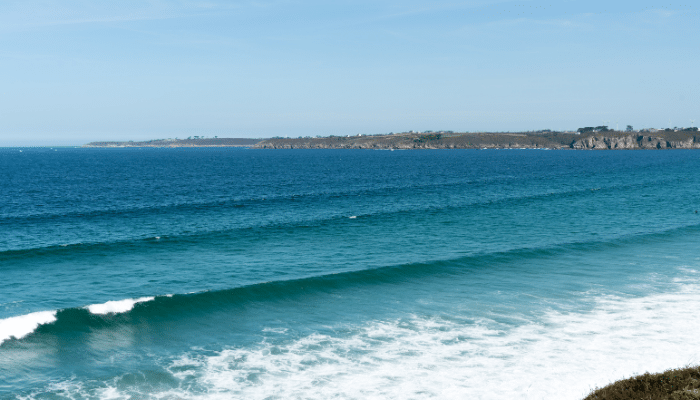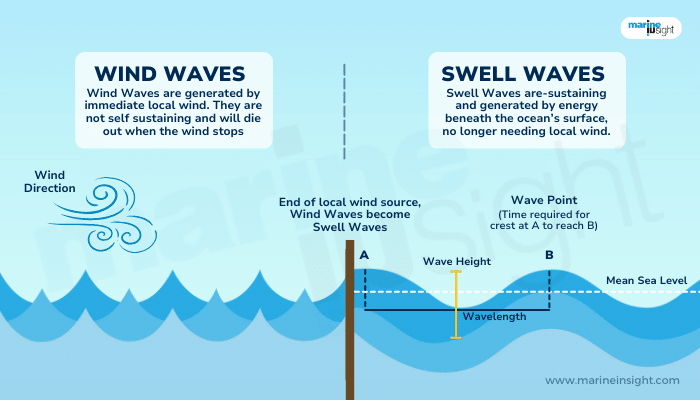Swell v/s Wave- What’s The Difference?
The ocean is a highly random environment subject to the whims of nature. Waves are defined more technically as disturbances in the water surface due to the action of some external agent. These external agents are of the following types:
- Winds, with their interaction with the gravity forces, the most common ones, are also known as the gravity waves.
- Tidal waves caused by the action of tides (gravitational interaction between the earth, sun and the moon).
- Seismic activities like earthquakes or tsunamis
- Man-made factors like explosions, etc.
Wind waves are the most predominant kinds of waves that are always present on the sea surface. The formation of waves is essentially due to the energy transfer that takes place from the wind forces to the water surface. These factors that contribute to this energy imparted and, thus, the nature of the waves driven by winds are:
- Strength or intensity of the wind
- Duration or the amount of time the winds over a particular area blow without any interruptions.
- Fetch which is essentially the extent over which a particular stream of wind blows without changing direction.

Waves are now mostly characterised by three major parameters:
- Direction
- Wave length
- Wave period
- Wave height
Wave height gives us an idea of the maximum levels at which a wave can surge above the mean sea level. Wavelength, as we know, defines the length of a single wave, that is, between two successive crests or troughs. Wave period is the time taken for one wavelength to pass through a given point. The direction of a wave, in turn, can be unidirectional or multi-directional.
Now, when we commonly speak of waves, we refer to those created by winds acting locally. In other words, due to the impact of the interaction between the sea surface over a particular region and the local wind pattern, most of the wave trains are created. They are locally behaving, and a particular train of waves chosen as random dissipates all its energy and travels only a limited amount of distance.
At this stage, it is important to know about a specific kind of waves known as swells. Swells are formed due to very strong wind forces, like during storms, cyclones, hurricanes, or even long periods of fierce gale winds. Here, in such areas of strong wind forces, there is a huge amount of energy transfer that takes place to the water surface. As a result, not only does the sea get roughened up, but also the effect of the winds continues to linger over larger times and distances.

We noted above that the waves are a function of wind strength, time, and fetch. Imagine this simple situation: You drop a pebble in a calm pond. As it strikes the water and sinks, ripples are created, which travel outward from the point of impact. However, imagine you are strong enough to pick up a massive boulder and hurl it into the waters. What happens? The waters get roughened up even more, and more importantly, the ripples get more prominent and frequent, with some of them even ending up lapping on the banks where you are sitting.
The same happens in the seas during rough weather. The intensity of the wind imparts a large degree of energy underwater. Due to the high effect of the wind forces over a prolonged period and also affecting longer distances, several trains of waves are formed over large extents away from the area of impact. The propagation of such numerous series of random waves over large distances is what is technically known as wave dispersion.
This wave dispersion is the basis for swells to occur. Initially, the trains of waves formed combine short, intermediate, and larger waves flowing outwards. Now, from the wave theory, waves having longer wavelengths have higher speeds and are capable of travelling longer ranges.

Furthermore, as longer waves are associated with a larger energy index, they are not easily dissipated on their way, which is a common phenomenon for shorter, low-energy waves. Hence, low-energy, smaller, and scattered waves are filtered out, and longer wave components remain travelling over greater distances at higher speeds.
These waves start losing energy at some large distances away from formation, and as a result, their wave heights start to decrease and ‘flatten out’. Some more wave series are nullified further due to continuous loss of energy. In the end, only some definite trains of low-crested, flattened waves travel further at constant speeds towards a particular direction in what is known as the swell.
If the external conditions do not change significantly and there is no further obstruction, swells attain a state of constancy where uniform wave trains of more or less fixed amplitudes or heights, periods, speeds, and frequencies continue to travel linearly over large distances.
Often, these swells constructively interfere with one another linearly to give rise to combined wave systems with higher energies and as a result, they can travel even farther. Once the swells reach a state of constancy or saturation, they are even unaffected by localised disturbances like winds, which are within moderate levels. However, on reaching shallow waters close to the shoreline, they rapidly lose energy, become shorter in length, and break as surfs.
Hence, of all the wave patterns we carefully observe close to a shore or coast, not all are local short-term waves formed due to the local effects of the surrounding weather conditions. Many such groups of waves can be swells that are formed as a result of effects from faraway locations.
Thus, to summarise, waves can be any random disturbance that can be formed over an area, but swells are essentially specific trains of transformed, deep-water, long, high-speed, and linear patterns of waves that can travel over large distances without much dissipation of energy.
It can also be said swells are a definite category of waves, but not all waves are swells. Swells being observed can indicate a weather pattern or disturbance over some other location. However, for all practical purposes, merely observing a swell makes it impossible to determine its location of origin.
Swells originating from warm tropical summer storms in the Indian Ocean have reportedly been said to travel as far as the coasts of North America! Large groups of constant swells lashing near a shore can also be precursors to an incipient weather event like cyclones or hurricanes.
To conclude, let us summarise the differences between a normal wave and a swell:
- To recapitulate, by definition, a wave is any random disturbance that can occur in the sea. Swells are specific kinds of deep-water, linear, long-range wind-driven waves that emanate or filter out of a random wave system during an external weather event due to wave dispersion.
- Waves can be of any form, type, shape, height, period, direction, and speed. Swells travel only in a specific direction as more or less uniform, high-speed, long waves that remain constant over time. The speeds, in turn, are a function of the wavelengths and periods.
- Swells travel much larger distances as compared to any ordinary wave packet.
- Swells are unaffected by local weather systems.
- As compared to random waves, swells move in series only towards a particular direction.
- Physically, swells have a smooth and streamlined appearance with ‘flattened crests. More importantly, their pattern resembles more or less uniformity with equal intervals and periods.
- Swells appear as symmetrical wave distributions that do not change much in speed if you observe them over an area over time before they break into surfs. In deeper waters, they do not seem to lose their momentum over a certain distance.
- In terms of directionality, they are characterised by the direction from where it emanates instead of where it is headed.
Swells often hinder the seakeeping and manoeuvring abilities of vessels in deep waters.
You might also like to read-
- What are Rogue Waves?
- Different Types of Sea Waves – A Comprehensive List
- The World’s Largest Wave Farm
- How Do Ships Survive Storms?
Disclaimer :
The information contained in this website is for general information purposes only. While we endeavour to keep the information up to date and correct, we make no representations or warranties of any kind, express or implied, about the completeness, accuracy, reliability, suitability or availability with respect to the website or the information, products, services, or related graphics contained on the website for any purpose. Any reliance you place on such information is therefore strictly at your own risk.
In no event will we be liable for any loss or damage including without limitation, indirect or consequential loss or damage, or any loss or damage whatsoever arising from loss of data or profits arising out of, or in connection with, the use of this website.
Disclaimer :
The information contained in this website is for general information purposes only. While we endeavour to keep the information up to date and correct, we make no representations or warranties of any kind, express or implied, about the completeness, accuracy, reliability, suitability or availability with respect to the website or the information, products, services, or related graphics contained on the website for any purpose. Any reliance you place on such information is therefore strictly at your own risk.
Do you have info to share with us ? Suggest a correction
Subscribe To Our Daily Newsletter
By subscribing, you agree to our Privacy Policy and may receive occasional deal communications; you can unsubscribe anytime.



BE THE FIRST TO COMMENT